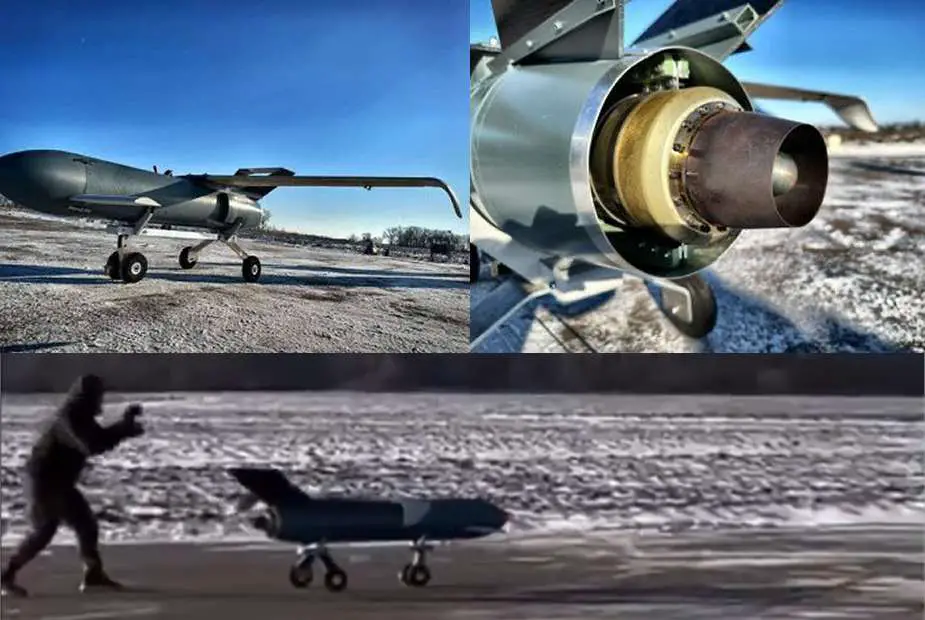- Army
- Conflicts in the world
- Israel - Iran conflict 2025
- Pakistan - India Conflict 2025
- Russia Ukraine War 2022
- Libya conflict day by day
- HAMAS - Israel War 2023
- Operation Serval in Mali French Army
- Sangaris operation Central African Republic
- Sangaris opération militaire République Centreafrique
- Ukraine - Russia conflict
- Syria conflict news
- Defence & Security Industry Technology
- Armies in the world
- Analysis Defense and Security Industry
- Conflicts in the world
- Navy
- Air
Ukraine develops new jet-powered kamikaze unmanned aerial vehicle
Ukraine is developing a new type of kamikaze drone equipped with a jet engine. This innovation represents a significant advancement in the country's offensive capability, offering superior performance compared to traditional propeller-driven drones. However, the use of a jet engine in these kamikaze drones raises several questions, both strategically and economically. This new drone can be seen in a tweet from Ukraine Battle Map dated January 17, 2024.
Follow Army Recognition on Google News at this link

The main advantage of these jet-powered drones lies in their increased speed and range (Picture source: Twitter account of Ukraine Battle Map)
The main advantage of these jet-powered drones lies in their increased speed and range, allowing them to quickly reach distant targets and maneuver more effectively in contested airspace. These capabilities are crucial in the current context, where the speed and precision of strikes can determine the outcome of confrontations. Additionally, certain aspects of their design could offer stealth advantages, making these drones less detectable by enemy defense systems.
The difference in payload capacity between a jet-powered drone and a propeller drone is significant and has important implications on the battlefield. Jet-powered drones, thanks to their superior propulsion power, can generally carry heavier loads, including more significant armaments or advanced surveillance equipment. This allows them to conduct more devastating strikes or carry out more in-depth reconnaissance missions. In contrast, propeller drones are often limited in terms of payload due to their lower propulsion power and design focused on endurance rather than speed. On the battlefield, this difference translates into an increased ability for jet-powered drones to engage targets with greater force or carry sophisticated equipment for reconnaissance or electronic warfare missions, thus offering a substantial tactical advantage.
However, the use of jet engines on drones destined to be destroyed in their mission raises questions about cost and efficiency. These engines, more expensive and complex than the classic engines of drones, significantly increase the unit cost of each drone. In a context where resources may be limited, investment in such systems must be carefully weighed against the tactical advantages they bring.
Moreover, the reliability of these drones in combat situations is a major concern. Incidents, where the payload has not properly detonated, have been reported, highlighting the need for constant refinement in the design and deployment of these technologies.
In comparison, enemy drones, especially those developed by Russia, have also evolved, presenting their own adaptations and innovations. This arms race in the drone domain implies a need for continuous adaptation and development to maintain a tactical advantage.
The development of kamikaze jet-powered drones by Ukraine represents a notable evolution in drone warfare, offering enhanced capabilities in terms of speed and range. However, the challenges related to cost, reliability, and operational efficiency of these systems remain critical issues. It remains to be seen if Ukrainians will be able to produce them in mass. This development highlights the dynamic and constantly evolving nature of modern military technology, as well as the need for continuous evaluation of strategies and capabilities in the field of unmanned aerial warfare, a sector that has gained immense importance in the war in Ukraine and around the world.


























